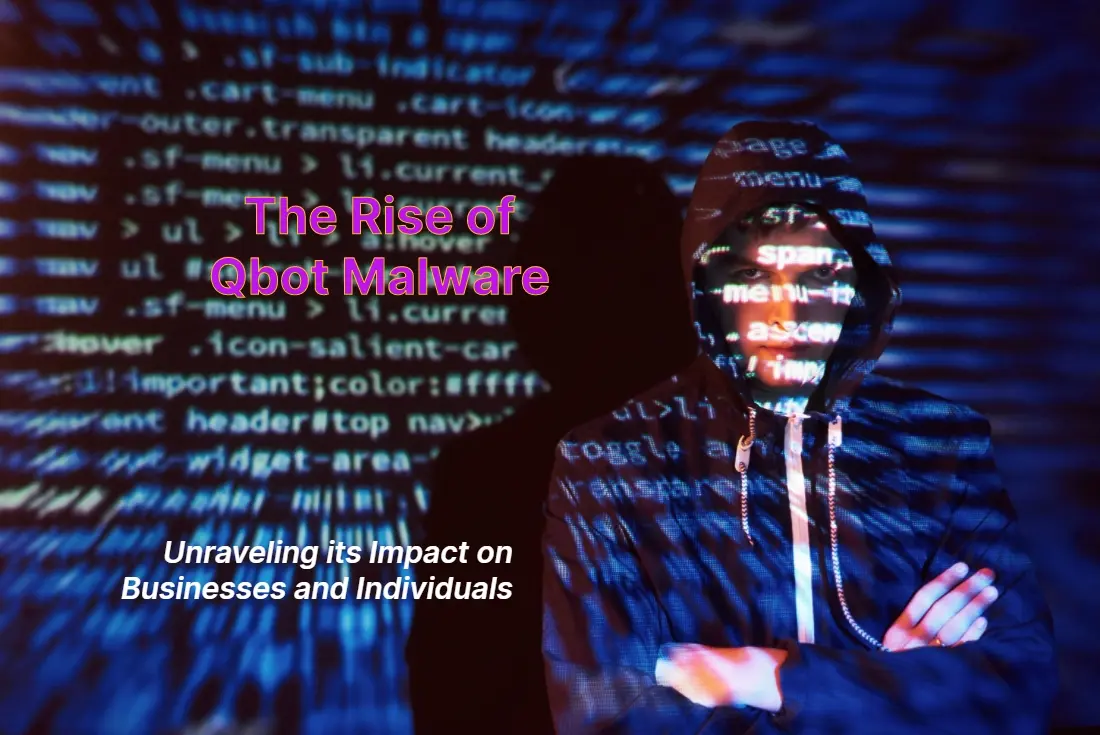
11 Oct The Rise of Qbot Malware: Unraveling its Impact on Businesses and Individuals
The threat landscape in cyberspace is constantly evolving, and one malicious software that has recently gained notoriety is Qbot malware. This insidious malware has been wreaking havoc on both businesses and individuals, leaving a trail of financial loss and sensitive data breaches in its wake. In this article, we will delve deep into the rise of Qbot malware, unraveling its impact on unsuspecting victims.
Qbot, also known as Qakbot or Pinkslipbot, is a sophisticated banking trojan that has been around since 2008. Over the years, it has evolved and adapted to bypass security measures, making it increasingly challenging to detect and remove from infected systems. Qbot spreads primarily through malicious email attachments and exploit kits, leveraging social engineering techniques to trick victims into clicking on infected links or downloading malware-laden files.
Once infiltrated, Qbot has the ability to steal sensitive information, such as banking credentials, personal data, and login credentials, which can then be used for financial fraud and identity theft. Additionally, it can also self-propagate and spread to other connected devices, exacerbating the damage.
With the rise of Qbot malware, it is crucial for businesses and individuals to be aware of its impact and take proactive measures to protect themselves from this pervasive threat. In the following sections, we will explore the various ways in which Qbot can compromise security and discuss effective defense strategies to mitigate its impact.
How the Qbot malware works
Qbot, also known as Qakbot or Pinkslipbot, is a sophisticated banking trojan that has been around since 2008. Over the years, it has evolved and adapted to bypass security measures, making it increasingly challenging to detect and remove from infected systems. Qbot spreads primarily through malicious email attachments and exploit kits, leveraging social engineering techniques to trick victims into clicking on infected links or downloading malware-laden files.
Qbot is designed to remain stealthy and persistent on infected systems, making it difficult to detect. Once infiltrated, it establishes a foothold and starts collecting sensitive information from the victim’s device. It targets a wide range of data, including banking credentials, personal information, and login credentials for various online accounts.
The malware employs key logging techniques to capture keystrokes, enabling it to steal usernames, passwords, and other confidential information entered by the victim. It can also intercept network traffic, allowing it to capture sensitive data transmitted over unencrypted connections. Qbot is designed to be modular, which means it can be updated remotely to include new functionalities and evade detection.
Is it necessary to clean your computer of malware, viruses, or spyware?
Your computer’s infection issue can be resolved with Downtown Computer Services. Our cybersecurity specialist is ready to examine your computer for malware and viruses and eliminate any infestations. You can reach us by phone at 954.524.9002 or online using the form.
Common methods of Qbot malware distribution
Qbot malware employs various methods to propagate and infect new systems. One of the most common methods is through malicious email attachments. Cybercriminals send out phishing emails that appear legitimate, often masquerading as banks, financial institutions, or reputable organizations. These emails contain attachments that, when opened, execute the Qbot malware on the victim’s device.
Another method is through exploit kits, which are software packages designed to exploit vulnerabilities in outdated software. Qbot takes advantage of these vulnerabilities to gain unauthorized access to a system and install itself. Once inside, it can download additional malware or carry out its malicious activities.
Lately, Qbot has also been distributed through malicious websites and malvertising campaigns. Cybercriminals compromise legitimate websites and inject malicious code into them. When users visit these compromised websites, they unknowingly download the Qbot malware onto their devices. Malvertising campaigns involve the placement of malicious advertisements on legitimate websites, which redirect users to websites that host the Qbot malware.
Impact of Qbot malware on businesses
The impact of Qbot malware on businesses can be devastating. Once a system is infected, Qbot can compromise sensitive business data, including financial records, customer information, and intellectual property. This can lead to financial loss, reputational damage, and potential legal consequences.
Qbot’s ability to steal banking credentials poses a significant threat to businesses. Cybercriminals can use these credentials to perform fraudulent transactions, drain bank accounts, and even initiate unauthorized wire transfers. In some cases, Qbot has been used to target specific businesses, such as financial institutions or organizations with high-value accounts, resulting in substantial financial losses.
Moreover, Qbot’s ability to self-propagate within a network can amplify the damage. Once it infects one device, it can spread to other connected devices, compromising the entire network. This can lead to widespread disruption of business operations, loss of productivity, and increased recovery costs.
Case studies: Real-life examples of businesses affected by Qbot malware
Several high-profile cases highlight the impact of Qbot malware on businesses. In 2019, a major financial institution experienced a significant data breach due to Qbot malware. The malware was able to bypass their security measures and gain access to sensitive customer information, including account details and social security numbers. The breach resulted in a loss of customer trust, regulatory fines, and costly remediation efforts.
In another case, a manufacturing company fell victim to a Qbot malware attack, resulting in the theft of their intellectual property and trade secrets. The stolen information was used by a competitor to gain a competitive advantage, leading to financial losses and a decline in market share for the affected company.
These real-life examples demonstrate the severity of the impact that Qbot malware can have on businesses. It underscores the need for robust cybersecurity measures and proactive defense strategies to mitigate the risk.
Impact of Qbot malware on individuals
Qbot malware doesn’t just target businesses, it also poses a significant threat to individuals. Once infected, Qbot can access personal information stored on the victim’s device, such as social security numbers, credit card details, and login credentials for various online accounts.
This stolen information can be used for identity theft, where cybercriminals assume the victim’s identity to carry out fraudulent activities, such as opening new credit accounts or making unauthorized purchases. Identity theft can have serious financial and emotional consequences for individuals, as they may be left with significant debts and the arduous task of restoring their compromised identity.
Additionally, Qbot’s ability to capture keystrokes and intercept network traffic puts individuals at risk of financial fraud. Cybercriminals can use the stolen information to gain unauthorized access to online banking accounts, credit card accounts, and other financial services. This can result in unauthorized transactions, drained bank accounts, and a loss of personal savings.
Steps to protect your business and personal devices from Qbot malware
To protect your business and personal devices from Qbot malware, it is essential to implement robust cybersecurity measures and follow best practices. Here are some steps you can take:
Keep your software up to date
Regularly update your operating system, applications, and antivirus software to patch vulnerabilities that cybercriminals may exploit.
Be cautious with email attachments
Exercise caution when opening email attachments, especially if they come from unfamiliar or suspicious sources. Scan attachments with antivirus software before opening them.
Educate employees and individuals
Train employees and individuals on how to identify and avoid phishing emails and malicious websites. Teach them to be skeptical of unexpected attachments or links, even if they appear to be from trusted sources.
Use strong, unique passwords
Encourage the use of strong, complex passwords and enable multifactor authentication whenever possible. Avoid using the same password for multiple accounts.
Regularly back up your data
Regularly back up your important business and personal data to an external device or cloud storage. In the event of a Qbot infection or any other data breach, you can restore your data without significant loss.
Implement network segmentation
Segment your network to limit the spread of malware in the event of an infection. This can help contain the impact and prevent Qbot from moving laterally within your network.
Invest in a comprehensive cybersecurity solution
Deploy a robust cybersecurity solution that includes antivirus software, intrusion detection systems, and firewalls to detect and block Qbot malware and other threats.
How to detect and remove Qbot malware
Detecting and removing Qbot malware can be challenging due to its sophisticated nature. However, there are several steps you can take to detect and remove malware from your system:
1. Use reputable antivirus software
Install and regularly update reputable antivirus software that includes Qbot detection capabilities. Perform regular scans to identify and remove any detected malware.
2. Monitor network traffic
Implement network monitoring tools to detect suspicious network traffic patterns that may indicate the presence of Qbot malware. Monitor for outgoing connections to known Qbot command-and-control servers.
3. Conduct regular system scans
Regularly scan your system using specialized removal tools designed to detect and remove Qbot malware. These tools can help identify and remove any traces of malware that may have evaded traditional antivirus software.
4. Seek professional assistance
If you suspect your system is infected with Qbot malware, it is recommended to seek professional assistance from a cybersecurity expert or incident response team. They have the expertise and tools to effectively detect and remove malware from your system.
The future of Qbot malware and cybersecurity measures
As cybersecurity measures continue to evolve, so does the sophistication of Qbot malware and other malicious software. Cybercriminals are constantly adapting their techniques to evade detection and exploit vulnerabilities. It is essential for businesses and individuals to stay vigilant and continuously update their cybersecurity strategies to protect against evolving threats.
The future of Qbot malware is uncertain, but it is likely to become even more sophisticated and difficult to detect. Cybersecurity professionals must stay ahead of the curve by leveraging advanced technologies such as artificial intelligence and machine learning to detect and prevent Qbot infections.
Additionally, collaboration and information sharing among cybersecurity professionals and organizations are crucial in combating Qbot malware and other threats. By sharing threat intelligence and best practices, the industry can collectively work towards minimizing the impact of Qbot and protecting businesses and individuals from its malicious activities.
Conclusion: Importance of staying vigilant against evolving malware threats
Qbot malware presents a significant threat to both businesses and individuals, with the potential for financial loss, data breaches, and identity theft. Its ability to evolve and adapt makes it a formidable adversary, challenging traditional cybersecurity measures.
To protect against Qbot malware, businesses and individuals must prioritize cybersecurity and implement robust defense strategies. This includes regular software updates, employee education, strong passwords, data backups, and the use of comprehensive cybersecurity solutions.
Furthermore, staying vigilant and proactive is crucial in the face of evolving malware threats. By staying informed, adopting best practices, and collaborating with the cybersecurity community, we can collectively defend against Qbot malware and other emerging threats, ensuring the safety of our digital lives and businesses. For assistance in eliminating malware and viruses from your computer, get in touch with the professionals at Downtown Computer Services. Our expert in computer security is prepared to check your computer for viruses and malware and remove any infections. Use the web form to send us a message, or give us a call at 954.524.9002!
Check out other relevant news
- How Easy-to-Use Hacking Tools Are Fueling Cybercrime
- Cryptocurrency Security for Small Businesses: Protecting Your Wallet
- The Infostealer Epidemic: Protecting Your Business from the Latest Wave of Cyberattacks
- The Identity Crisis: How Compromised Credentials Can Cripple Your Business
- Beyond the Brick and Mortar: Building Your Online Storefront with Digital Marketing
